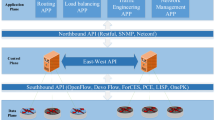Abstract
This paper proposes a scheme to practically resolve the load imbalance state for orchestrated multiple controllers architecture in software-defined networks (SDN). Multiple controllers architecture is crucial to SDN implementation in large scale networks because this architecture provides efficient performance for end-to-end services, such as reliability and scalability in SDN networks. However, when there are multiple SDN controllers in the network, a load imbalance state may occur. The load imbalance problem can notably degrade service level in some parts of the network because the SDN controllers in those network areas have much higher amount of processing load. Existing works solved the load imbalance problem by migrating the load to multiple SDN controllers in order to maintain an acceptable level of load in all SDN controllers. Nevertheless, most of these works did not consider propagation delay and processing time in their load definition. In large-scale networks, high propagation delay is likely to cause late response from the SDN controller, which may result in a degraded performance in the SDN networks. In this paper, a new load balancing scheme is proposed. The proposed scheme is formulated as an integer linear programming problem (ILP). It defines SDN controller’s load based on propagation delay, processing time at the controller and the number of request messages in order to provide an accurate representation of load in practical environments. Generally, ILP may take a long period of time to process. Therefore, a heuristic algorithm that bases on the proposed load balancing scheme is also developed to provide shorter processing time. Computer simulations and practical implementation in Pica8 switch show that the proposed scheme reduces the average maximum load by at least 9.85%, compared to a conventional scheme.


















Similar content being viewed by others
References
McKeown, N.: Software-defined networking. In: Proceedings of the IEEE conference on computer communications (INFOCOM), pp. 30–32 (2009)
Wang, T., Liu, F., Guo, J., Xu, H.: Dynamic SDN controller assignment in data center networks: stable matching with transfers. In: Proceedings of the IEEE conference on computer communications (INFOCOM), pp. 1–9 (2016)
Wang, K., Kao, S., Kao, M.: An efficient load adjustment for balancing multiple controllers in reliable SDN systems. In Proceedings of the IEEE International conference on applied system innovation (ICASI), pp. 593–596 (2018)
Zhang, B., Wang, X., Huang, M.: Adaptive consistency strategy of multiple controllers in SDN. IEEE Access 6, 78640–78649 (2018)
Hu, T., Yi, P., Zhang, J., Lan, J.: Reliable and load balance-aware multi-controller deployment in SDN. China Commun. 15(11), 184–198 (2018)
Chen, W., Chen, C., Jiang, X., Liu, L.: Multi-controller placement towards SDN based on Louvain heuristic algorithm. IEEE Access 6, 49486–49497 (2018)
Bhole, P.D., Puri, D.D.: Distributed hierarchical control plane of software defined networking. In: Proceedings of the International conference on computational intelligence and communication networks (CICN), pp. 516–522 (2015)
Sufiev, H., Haddad, Y.: A dynamic load balancing architecture for SDN. In: Proceedings of the IEEE International conference on the science of electrical engineering (ICSEE), pp. 1–3 (2016)
Cui, J., Lu, Q., Zhong, H., Tian, M., Liu, L.: A load-balancing mechanism for distributed SDN control plane using response time. IEEE Access 15, 1197–1206 (2018)
Xu, Y., Wang, I., Walid, A., Wilfong, G., Wen, C., Marchese, M., Chao, H.: Dynamic switch migration in distributed software-defined networks to achieve controller load balance. IEEE J. Sel. Areas Commun. 37(3), 515–529 (2019)
Duy, P.T., Hien, D.T.T., Qui, H.P., Pham, V.: Aloba: A mechanism of adaptive load balancing and failure recovery in distributed SDN controllers. In: Proceedings of the IEEE 19th International Conference on Communication Technology (ICCT), Xi’an, China, pp. 1322–1326 (2019)
Singh, A., Tiwray, M., Kumar, R., Misra, R.: load balancing among wide-area SDN controllers. In: Proceedings of the International Conference on Information Technology (ICIT), Bhubaneswar, pp. 104–109 (2016)
Wang, C., Hu, B., Chen, S., Li, D., Liu, B.: A switch migration-based decision-making scheme for balancing load in SDN. IEEE Access 5, 4537–4544 (2017)
Selvi, H., Gür, G., Alagöz, F.: Cooperative load balancing for hierarchical SDN controllers. In: Proceedings of the IEEE International conference on high performance switching and routing (HPSR), pp. 100–105 (2016)
Chen, Y., Li, C., Wang, K.: a fast converging mechanism for load balancing among SDN multiple controllers. In: Proceedings of the IEEE Symposium on Computers and Communications (ISCC), Natal, pp. 682–687 (2018)
Beiruti, D.M.A., Ganjali, Y.: Load migration in distributed SDN controllers. In: Proceedings of the IEEE/IFIP Network Operations and Management Symposium, Budapest, Hungary, pp. 1–9 (2020)
WilsonPrakash, S., Deepalakshmi, P.: Artificial neural network based load balancing on software defined networking. In: Proceedings of the IEEE International Conference on Intelligent Techniques in Control, Optimization and Signal Processing (INCOS), Tamilnadu, India, pp. 1–4 (2019)
Xie, J., Guo, D., Hu, Z., Qu, T., Lv, P.: Control plane of software defined networks: a survey. Comput. Commun. 67(1), 1–10 (2015)
Guillen, L., Takahira, H., Izumi, S., Abe, T., Suganuma, T.: On designing a resilient SDN C/M-plane for multi-controller failure in disaster situations. IEEE Access 8, 141719–141732 (2020)
Kitsuwan, N., Ba, S., Oki, E., Kurimoto, T., Urushidani, S.: Flows reduction scheme using two MPLS tags in software-defined network. IEEE Access 5, 14626–14637 (2017)
Kitsuwan, N., Tahara, H., Oki, E.: Heuristic approach to determining cache node locations in content-centric networks. IEEE Access 6, 1542–1549 (2018)
Barabási, A.-L., Albert, R.: Emergence of scaling in random networks. Science 286(5439), 509–512 (1999)
Loux, J., Li, D., Wu, J.: Configuring and controlling a software defined network with a pica8 switch. In: Proceedings of the IEEE Sarnoff symposium, pp. 1–2 (2016)
Asadollahi, S., Goswami, B., Sameer, M.: Ryu controller’s scalability experiment on software defined networks, In: Proceedings of the IEEE International conference on current trends in advanced computing (ICCTAC) (2018)
Author information
Authors and Affiliations
Corresponding author
Additional information
Publisher's Note
Springer Nature remains neutral with regard to jurisdictional claims in published maps and institutional affiliations.
Rights and permissions
About this article
Cite this article
Srisamarn, U., Pradittasnee, L. & Kitsuwan, N. Resolving Load Imbalance State for SDN by Minimizing Maximum Load of Controllers. J Netw Syst Manage 29, 46 (2021). https://doi.org/10.1007/s10922-021-09612-w
Received:
Revised:
Accepted:
Published:
DOI: https://doi.org/10.1007/s10922-021-09612-w




